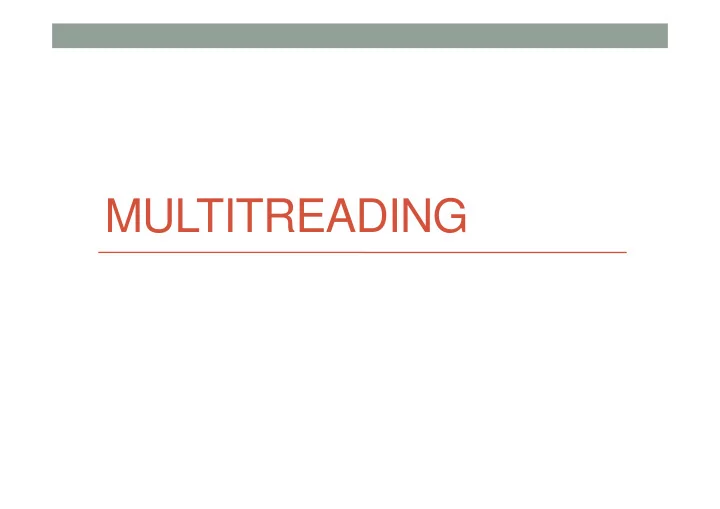

MULTITREADING
What is a thread? • A thread is a concurrent unit of execution • Threads share process’s resource but are able to execute independently • Each thread has a call stack for methods being invoked • A VM may run several threads in parallel • True parallelism for multi-core CPU • A VM has at least the main thread running when it is started
Why to use threads • Multi-thread programming is hard, so why to use it? • If the execution time of the main thread is higher than 5 s, then the OS displays an error message (ANR) • Slow tasks (like file downloading), cannot run in the main thread; so, in this case you must use multiple threads • In a multi-core CPU, multiple threads can truly run in parallel
How to use multi-tread? • classic Thread programming • Special care must be taken as only main thread can update the UI, • Android’s AsyncTask • Android’s AsyncTask • It’s a class that simplifies the interaction with the main thread • Service • Background work can be performed in a background service, using notification to inform the user about the next step
How to create a thread • There are basically two main ways for a Thread to execute application code. • One is providing a new class that extends Thread and overriding its run() method. overriding its run() method. • The other is providing a new Thread instance with a Runnable object during its creation. • In both cases, the start() method must be called to actually execute the new Thread.
First method: extending the thread class Anonymous thread The start method may initialize some data, then the run method is called The run method hosts the code to be run in a thread
What happens if the Activity is stopped? The thread in no longer • A thread has its own anonymous lifetime, independent from the creator • If an activity wants to This is a handler of a stop a thread on its button in UI ending, it has somehow ending, it has somehow to stop the thread(s) it launched • One way is to use a simple boolean flag in run method for returning prematurely Check the running condition
2 nd method: Implementing the runnable interface • Another option to get a thread is implementing the runnable interface • The interface has a single method, run , that hosts the code to be run hosts the code to be run concurrently • In this way, the thread could extend other classes (recall java only allows single inheritance)
Interacting with the UI • The background thread may need to update the UI according to its progress • This means that at any time the background thread may need to communicate with the main thread • This interaction is achieved through a message based mechanism • The background thread sends a message to the main thread after it obtains a token (permission to send) • The main thread processes the message
Interacting with the UI Background Main thread Main thread thread thread obtainMessage obtainMessage Handler sendMessage • The UI thread creates a Handler object internal to itself • The working thread uses this object to obtain an empty message and send a message to the UI thread
Example (HandlerThreadDemo) This is the handler object internal to the UI thread internal to the UI thread It updates a TextView object
Example (HandlerThreadDemo) A new thread is started Send a simple message that updates the textview
Passing data through the message • Create a bundle • Put data in • Set the data field of the message • Get bundle from the message • Get the data
AsyncTask • AsyncTask is a class that simplifies the interaction with UI • This class allows to perform background operations and publishes the results on the UI thread, without having to manipulate threads and/or handlers. manipulate threads and/or handlers. • An asynchronous task is defined by a computation that runs on a background thread and whose result is published on the UI thread.
AsyncTask
Example: (AsyncDemo) Select from eclipse widgets
Example
Example
Example
Example publishProgress generates publishProgress generates integers to mean the actual progress….
Example HTTP req/reply Credits: A Porter Dept. of Computer Science,University of Maryland
Example HTTP req/reply
Example HTTP req/reply
Example HTTP req/reply
Recommend
More recommend